Dogs may become fearful or have a strong emotional reaction to loud noises such as thunderstorms, fireworks, or garbage trucks. Some dogs fear being alone, while others become reactive when confined.
Different dogs have different temperaments and will react differently to various stimuli. Shy dogs may escape or run away at the first sign of trouble, while more confident dogs may decide to stay and fight. A naturally confident dog will recover from new and fearful experiences much faster than a naturally shy dog.
Young dogs tend to be more open to new experiences, and bounce back more quickly. This is why we want to socialize our dogs to many positive new experiences when they are young, so that they will grow up to be a confident and balanced adult dog.
However, we can train any dog to better handle stress or fear, and become more confident. All it takes is time, patience, and a lot of repetition. One of the best ways to calm a fearful or reactive dog is through the desensitization process.

Dog Desensitization – A Good Way to Calm a Dog
The desensitization process works by initially exposing a dog to very low levels of the problem stimulus. Once the dog becomes accustomed to the low level stimulus, we very slowly increase its intensity. Over time, our dog will learn to tolerate and be calm at even higher levels of the reactive stimulus.
Patience is key because we do not want to raise the stimulus potency too quickly and cause our dogs to lose control. Frequent loss of control (from fear or over-excitement) will not only set back our desensitization work, but also make our dog mistrust us, and become even more reactive.
Dog desensitization exercises are commonly combined with counter-conditioning techniques.

In addition to getting our dog calm and comfortable with the problem stimulus (desensitization), we also help him re-associate a previously negative stimulus with something positive (counter-conditioning).
Counter conditioning is achieved by engaging our dog in focus/eye-contact training and other simple dog obedience commands (e.g. Sit) during the desensitization process. When our dog stays calm and follows our commands we reward him well with affection and his favorite treats. In this way our dog learns to re-associate the ‘bad’ stimulus with calmness, yummy treats, and affection from us.
Note – We only reward good behaviors, i.e. our dog following commands and staying calm. Do not give treats or affection to your dog when he loses control, or when he is showing fear symptoms. If you do this with the wrong energy or technique, it will only encourage his reactivity and fears. Instead, just remove him to a quiet area where he can calm down on his own.
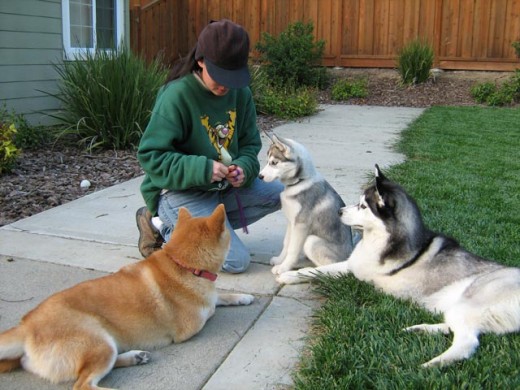
Calm a Dog to Noise

For a dog that is fearful or over-excited of loud noises such as fireworks or thunderstorms, the trigger stimulus is the noise. Therefore, our noise desensitization session would go something like this –
- We get a recording of fireworks or a thunderstorm and then play it (in loop mode) on our stereo at a very low volume. Make sure that the initial volume is low enough that our dog is able to stay calm.
- We engage our dog in focus and obedience exercises while the recording is playing and reward him well for staying calm and following commands.
- If everything is well, we increase the volume of our recording slightly and repeat step 2.
- If our dog stops accepting treats, or is no longer able to focus then we have moved forward too quickly. At this point we want to lower our volume by a few notches. Once our dog is calm again, we can repeat step 2.
- It is important to keep desensitization sessions short, positive, and rewarding. In this way, our dog will start to associate fireworks and thunderstorms with positive experiences rather than something that is threatening and stressful.
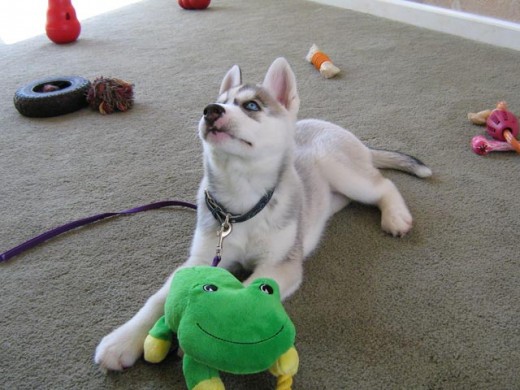
Calm a Dog to People

Dogs may also become anxious or over-excited when people come into their space and pet or hug them. Dogs are not humans, and they do not have the same communication cues as we do. When meeting a new dog, especially a shy dog, it is best to first ignore the dog and let him approach us.
We can help our dog become less fearful of people by desensitizing him using distance, focus, and rewards –
- Ask a friend to sit under a tree in our backyard and read a book.
- Meanwhile, we have our dog on-leash and stand far enough away from our friend that our dog is calm and relaxed.
- We get our dog’s focus and do some simple obedience exercises. He gets rewarded for staying calm and working together with us.
- If all is well, we move one step toward our friend and repeat step 3.
- It is important that our friend totally ignores the dog, which means no talking and no eye-contact. Eye-contact can be seen as an invitation to interact, or as a threat, especially by a shy dog. Either way, it can trigger an excited or fearful response.

As always, we want to keep desensitization sessions short, fun, and rewarding. In this way, our dog will learn to re-associate people with calmness and positive experiences.
- After several sessions, we may get close enough to our friend that she can throw some high priority treats to our dog. However, it is still important not to initiate eye-contact.
- If our dog is calm and does not have a bite history, we can let him come over and sniff our friend (still no eye-contact).
- Once our dog is comfortable with the scent of our friend and is calm, then we can bring her back a few paces and repeat the desensitization exercise with brief periods of eye contact.

In later stages we can repeat the desensitization process for –
- A person who is moving slowly.
- A person wearing unusually clothing, big hats, or carrying an umbrella.
- A person on a skateboard or bicycle.
- A person who is talking softly.
- A person who is talking in a high-pitched tone.
- A threatening person who is talking loudly.
The more things we desensitize our dog to, the more confident he will become and the more prepared he will be to handle new experiences.
However, patience is extremely important. The key to the desensitization process is to help dogs re-associate previously stressful or highly emotional situations with something calm and positive. Going too fast can scare our dog and cause him to become even more reactive of people.
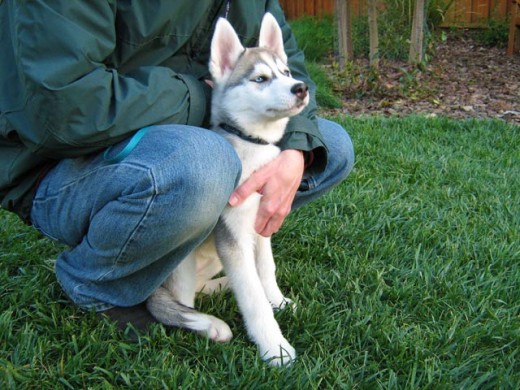
Calm a Dog to Confinement

Some dogs may get reactive when they are first confined in a crate. Confinement can be stressful because the dog loses his ability to escape if a threat should arise.
Before confining a dog in a crate for any length of time, it is best to first get the dog calm and desensitized to the crate.
- We start by showing the crate to our dog and letting him smell and examine it.
- Next we put some food near the entrance of the crate and let our dog step in to eat it.
- When he is comfortable with that, we throw some food deeper into the crate.
- We continue until our dog is cheerfully going into the crate on his own. At this point, make sure to leave the crate door open so our dog can move into and out of the crate freely.
- Once our dog is calmly moving into and out of the crate, we can close the door briefly. Wait one second, and then open the door again.
Finally, we slowly lengthen the time that our dog spends in the crate.
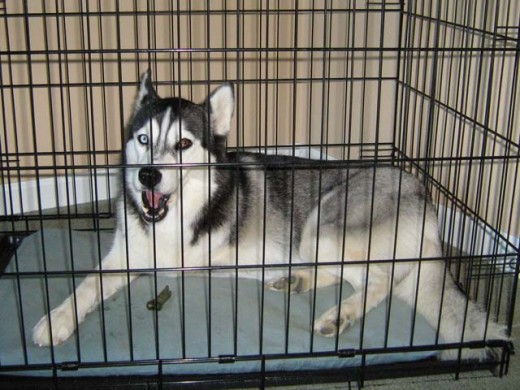
Desensitization vs. Flooding
In addition to desensitization, there is another technique called flooding that can also be used to deal with dog anxieties and fears.
With desensitization we expose a dog slowly to low amounts of the fear stimulus. We get the dog comfortable with the low level stimulus, then gradually train him to accept greater levels.
Flooding, on the other hand, exposes a dog to large amounts of the fear stimulus right away. The dog is then forced to experience the fear stimulus until he calms down.
Like us, a dog’s body can only keep pumping adrenalin for a fixed amount of time, i.e. there is a time limit to a dog’s fear response or panic attack. Theoretically, both human and dog will calm down after some time, realize that there is nothing to fear, and start to associate that new feeling of ease with the previously fearful stimulus.
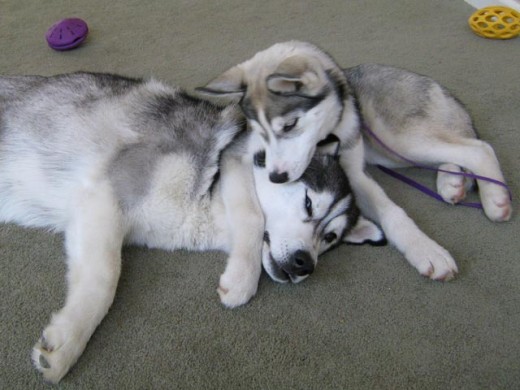
Flooding may be faster than the desensitization process, but it is risky, more traumatic, and may cause the dog to just shut down and stop responding.
Flooding is a psychotherapeutic method for overcoming phobias. This is a faster, yet less efficient and more traumatic, method of ridding fears when compared with systematic desensitization.
~~[Wikipedia]
For this reason, most animal behaviorists recommend using desensitization and counter conditioning methods to treat dog anxieties and fears. Desensitization may take more patience and more time, but it is safer, the results are long-lasting, and it helps to build a strong bond between us and our dog that is based on trust and respect.
The key to everything is patience. You get the chicken by hatching the egg, not by smashing it.
~~[Arnold H. Glasgow]

How do I stop a dog for going for other people
I have a 3 year old Aussie/Collie mix who we adopted from an acquaintance. When we move the couches in our living room he gets excited and wants to jump on you and sometimes barks. He doesn’t like it at all. Recently he tried to bite my mom when she moved the couches, she is scared of him now. I’m not sure how to approach this. Either to desensitize him or put him out whenever we move the couches. I don’t want my dog to be able to fly off the handle at such a small issue. Any suggestions out there? TIA!
Hi! My daughter has a greyhound and recently he was attacked by another dog while walking in a local park. He is recovering well from his substantial wounds but is refusing to walk in the local park anymore or anywhere from home location but will happily walk if we drive him to amother suburb. What can they do to regain his confidence to use the local park again. This has been going on for about a month now and he just does not move from the front of their apartment. What can be done? Moving house is not an option.
I have a 2 ans a half yr old pug bitch she is very outgoing and not shy at all. I do not let her off lead very often unless in safe surroundings although she does recall quite well. On a walk i started chatting to a friend in a field near my home i was getting tangled in the lead so let her off for 5 mins!! My friends male jack russell started to chase her very forcefully which scared her and she ran!! No matter how much i called her she would not come to me! She ran the same way i walk her and never went on the road thank god but i am most upset as too why she would not come to me?! I had to get a passerby to grab her!! What did i do wrong in this situation?! Not that it will be happening again.
Lie down where you are, make sure she sees you, when whine loudly like a puppy in pain. She’ll come back so fast…. 🙂 Works for my 4 month old puppy every time no matter how far. It’s instinct.
Hi!
I’ve recently rescued a 7 year old Shih Tzu from The Dogs Trust (UK), she was used for breeding on a puppy farm in Ireland and was just bread and bread until she was no use for breeding anymore, which was when she had her pups taken from here and either abandoned on the street or dumped in a kennel (we never got to the bottom of it)
I have another Shih Tzu that i’ve had from a pup and wanted a friend for her, Doris (the rescue) needed to be rehomed with another dog, as she’s always been around dogs and really enjoys the company.
However.. she hates us humans, she doesn’t like going for a walk, wont come to me when I call her (although she does acknowledge me) and she completely refuses to come out from underneath the coffee table,
She’s a very anxious little soul, she will let you stroke her but looks absolutely terrified when you do.
She excessively pants, and runs in circles on the odd occasion, I’ve only had her two weeks (tomorrow) and I can see little improvements in her, but could anyone suggest how I can possibly get her to start to trust me?
she loves treats and food, however you have to put it down in front of her to eat, or put your hand under the coffee table for her… if she treats are outside of the coffee table she ain’t interested.
all thoughts and advice welcomed,
beth xo
Hi beth,
I’ve had a few pound dogs now..and honestly…I just think it’s time. The more mistreated they were…the longer you have to give them. But to give you a time frame…the dogs I’ve cared for took anything from 8 weeks to a year to come out of their shell. They eventually trust and figure out you’re a good guy..but some I think will forever have trouble with sounds, other people etc…but they all have come good to me as an owner.
Treats and patience x
Best of luck with your shih tzu, Beth. I have the same situation with my Sheltie, Ida. She was a breeding dog for a back yard breeder until she was five, then dumped at a rural shelter when too old for use. I have had her for a year and a half now, and she is still extremely reactive to everyday situations, even ones experienced on a daily basis. She has become somewhat attached to me, but will still flinch when I first touch her. Other people still terrify her. When someone gets a puppy from a puppy mill, I wish they could see the damage and pain to the mothers left behind.
Keep doing your best with your little dog, but you may have to accept that some of the damage can never be undone. At least she is safe with your family and will never be harmed again.
My dog is extremely nervous. He is a 2 yr old huskymute and hes scared of loud noises, some other dogs and even the wind… This is to the point where his stool is extremely soft, he wont eat and wont even go for a walk. My neighbours have just installed a hanging parasol today which blows in the wind (you can imagine how much fun that must be for poor Storm) and now he wont even go into our conservatory or outside. My neighbours are neighbours from hell and when their parasol was encroaching onto our property my dad asked if they could move it back so it wasnt on our land. (A reasonable request if you ask me) and straight away, they started shouting (which only scared the poor boy more) and becoming very aggressive towards my father and myself. They were even f-ing and blinding which I didnt stand for and lost my cool. I just dont know how to adjust my dog to this new horrific nightmare… Its cruel cause he cant play outside or anything….
Hi, I recently rescued a 1 year old border collie from a friend (she couldn’t keep her anymore). I also have a 15 year old shiba Inu (which is my baby) my shiba is so afraid of the 1 year old, when she barks my shiba jumps and runs away shaking, when the pup gets near him (the shiba) he goes the other way with his head and tail down. The door we let the dogs to go out of to go potty is on the lower level to our house. If she’s down there he won’t even come down the stairs, it takes a lot of “cmon, it’s ok” talk to get him down, which before it was never a problem. Then when I finally get him out, he won’t come back in. The border collie is good with my shiba, wants to play naturally but for the most part she really leaves him alone. What could I do to help my shiba calm down and not be so nervous? I’m just worried that something may happen to him because he’s 15. I just want him happy and comfortable. Please help
Thanks
Kim
Hi, I have adopted a 5year old puppy mill spoodle. she gets along well with my 8 month dog.
she does have trust issues but we overcoming them slowly. my main problem is that as soon as a leash is pit on her she freezes. No treat or enticement works. she will drag the lead around, but as soon as she feels a tug or restraint she freezes again. When I take the leash off she stays still for a minute or so, and then slowly starts walking and realises freedom and becomes herself again.
Do you have suggestions on how I can slowly remedy this issue? I would love to take both dogs to the beach but without a leash I’m unable to.
She’s a beautiful dog, becoming to love cuddles, jumps on the bed in the morning fir attention
Thanks for any suggestions you can give.
Cheers
Patricia
I have a poodle that I adopted from the city pound 1/2/16. She is about 3 years old and was emaciated when we adopted her. Very skinny and sickly. I have never been around an animal that has so much anxiety. She is a really sweet dog. I can’t use positive reinforcement, yet, with this dog because she is too out of control to even want a reward. If I were having a panic attack, I wouldn’t want a reward either unless it’s a tranquilizer. She paces when she hears the toilet flush, she barks incessantly when the phone rings and she goes insane when our other dog barks. By insane, I mean she hears a couple of barks, she jumps up, runs in circles, tries to nip the other dog, barks uncontrollable and wont stop until we catch her. If we don’t catch her, she would probably run in circles for 10 minutes barking hysterically. If we don’t catch her, the other dog, a Chihuahua, will attack her. I see why because it annoys the humans as well as the dog in house. Once we catch her, after her pacing tantrum, we walk her to a quiet area. While I’m walking her out of the room, she little barks upside down (and all different directions), while her body is almost convulsing out of anxiety. We’ve tried “doggie zanax” and she paced like an intoxicated dog (bumping into walls). We had her on a leash in the house for the first couple of weeks to prevent a lot of this, but it seems cruel to keep her on a lease in the house forever. It seems like there are too many stimuli to identify. She paces, air licks and her head bobs back and forth when she walks outside to use the restroom. She’s too nervous outside to use the restroom during the day, so she secretly sneaks off to pee somewhere in the house. I’m assuming she is afraid to be attacked. If I was a stay at home mom I could dedicate 24 hours a day to her, but at this time I have my 77 year old mother spending time with her during the day and then in the evening I will spend time with her. I know some behaviorism, but my mother does not and she is going insane with this dog. Cupcake has improved slightly without meds. We have a decent size bathroom area, where she can go to relax when she is out of control. Then we bring her out when she stops barking hysterically. We also have a large pen outside that gives her outside time. We live on two acres, so she does not have any city loudness to deal with. We don’t lock her in with any of our other dogs, but she socializes with them throughout the day. That was a nightmare at first too, however, now she seems to tolerate the other dogs. She does not know how to play like a normal dog. She wants to play but she seems scared when the other dogs try to play with her. She doesn’t know how to be a dog. I’ve been teaching her how to play around the other dogs. I use therapeutic massage with her and it works. When I have days off, I take her hiking in to woods to work off the excess energy. Even after a 5 mile hike, she comes back home and paces back and forth. She has noise phobia from almost everything. The only time she is calm is when there is no sound. She will curl up and sit down next to us. What are your suggestions?
Sounds like my new rescue dog was caged indoors as broader dog in puppy mill, very long road in training her, trained therapy labs before so process is very difficult goog luck
Hi, I have a 6 month old border collie, that I recently “rescued” from a hell hole. I suspect that he has never been out and potentially mistreated.
He cannot grasp even the simplest of tasks as he seems to be in total fear.
I have attempted to take him out on a leash and he is ok when there’s nothing around, but when he sees people he is uncontrollable. Totally freaks out.
I have had dogs in the past, but never experience such behaviours before.
In the home he is loveable and affectionate, but seemingly non reactive to any basic learning.
He is also totally food focussed.
Have you any advice that may help?
Thank you